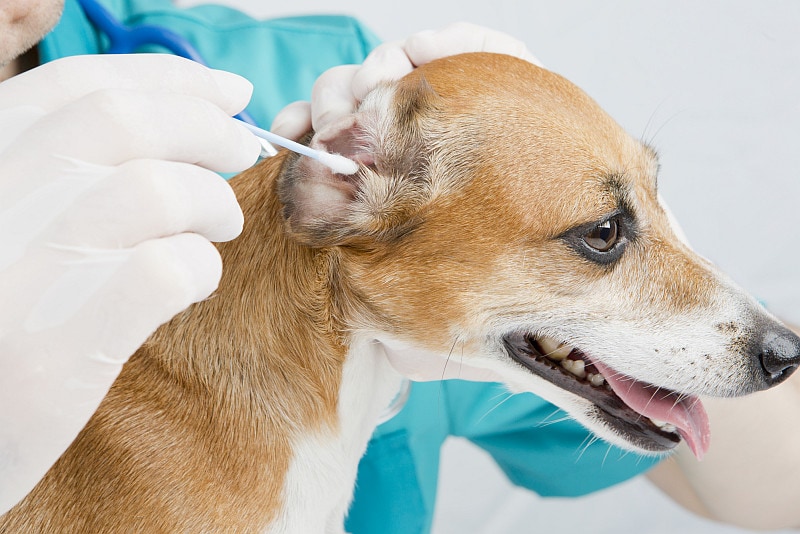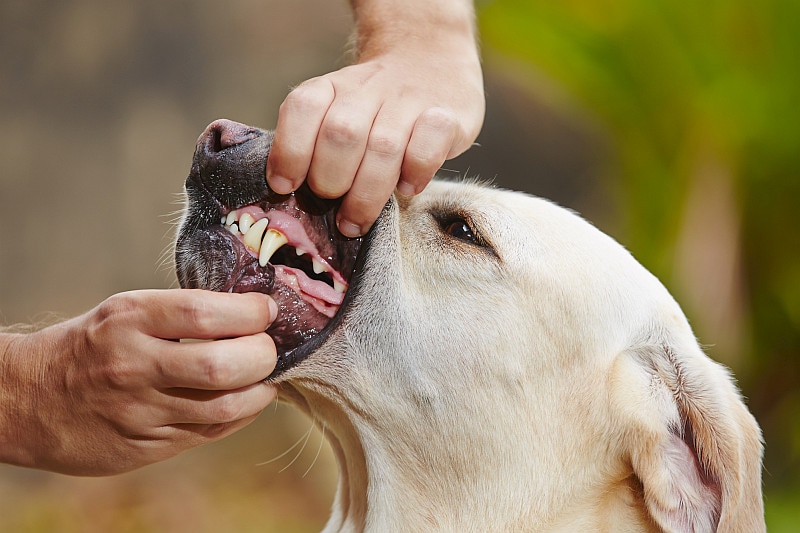As any pet owner knows, a visit to the veterinarian can be an expensive trip, but with a little knowledge, you can take care of some less serious dog issues on your own. So lets take a look how you can recognize the most common dog health problems and what you can do about them.
Dog Ear Infections
Ear infections are a very common canine problem. This ailment can be difficult to notice since it is mainly an internal issue. However, there are a large number of warning signs that can alert you to the presence of a dangerous ear infection. Dog ear infection symptoms may include:
- Frequent head shaking
- A persistent head lean (the dog will usually lean to the infected side)
- Frequent pawing and rubbing of the ears
- Nasty discharge from the ear
- Redness and swelling of the ear and the surrounding area
- Problems with maintaining balance
- Apparent hearing loss
- Scabs and crusty areas around the ear canal
- A terrible stink coming from the ears
- Loss of hair around the ears
- Reduced ability to chew
Some dogs have a higher risk of ear infections, and certain weather conditions can also make this condition more likely to occur.

If you see any of these signs, there is a good chance that your dog has some kind of ear infection. If you see multiple signs, there is a need to take action. The real problem in this situation is that there are many things that can cause an ear infection, and you need to know what is wrong before you can properly treat the issue.
The good news is that there are many over-the-counter ear drops that can help with these issues. Unless you happen to be a medical professional, we recommend that you take a diagnostic visit to the vet (which isn’t very expensive). Once you know the cause of the infection, you can treat it with the appropriate OTC remedy.
Dog Eye Problems
There are a number of eye problems that can affect a canine. As such, it is not realistic to think that you can educate yourself about all of them. That being said, you should look out for the following symptoms:
- Cloudy eyes
- Nasty mucus-like discharge from the eyes
- Swollen red nodules at the base of the eye
- Cuts, punctures, or tearing of the eye surface
- Eyes that are consistently sticky, puffy, and red
- Increased tear production
- Pupils that are always dilated
- An enlarged eyeball (one eye much bigger than the other)
Thankfully, most of these issues are easy to spot. Since dogs have a habit of getting right in their owner’s faces, you are more likely to notice an eye infection than, say, an ear infection. However, you should be aware that some diseases of the eye, like progressive retinal atrophy, are not likely to be spotted unless you are looking for them.
Pink Eye
The most common eye problem for dogs is conjunctivitis AKA “pink eye.” This is an infection that can occur in humans and most other mammals.
You have almost certainly seen a dog with some crusty yellow discharge around their eyes. In some cases, this is not a major problem. However, it can cause damage to your dogs’ vision if left untreated. Pink eye is easy to recognize and can be treated with some natural remedies like shown in the video.
Cherry Eye
In our list of symptoms, we mentioned the danger of swollen red nodules at the base of the eye. If you see this, you are looking at a third eyelid. A dog has two eyelids just like we do, but they also have a third eyelid that is internal. Small ligaments hold this third eyelid in place, where it provides extra protection to the inner eye.
However, when these ligaments break, the eyelids will prolapse and hang down from the bottom of the eye like big red tears. A prolapsed eyelid isn’t a huge problem on its own, but it is often an indicator of more significant issues.
Although this problem is sometimes treated with surgery, you have several options when it comes to home treatment.
Some have reported good results from a mixture of warm water and massage, claiming that the gland is eventually sucked back into place, where it can properly heal. There are also many types of eye drops and natural remedies that can speed this process along.
Dog Skin Issues
Canine skin may not be as visible as ours, but it can still suffer from many of the same issues. The most well-known skin problem for dogs would be mange (of which there is more than one type), but you should be on the lookout for these symptoms:
- Redness or rash
- Excessive scratching and biting
- Any abnormal discoloration of the skin
- Sores, bumps and scabs
- Blisters or pimples
- Greasy or scaly skin
- Dandruff
- Excessive shedding and hair loss
- Flea or tick infestation
- Excessive licking of a certain area
Thankfully, most of these conditions can be treated at home. Take a close look at your dog and make a list of all the unusual symptoms that you can find. By comparing this to a list of canine skin issues, you can probably identify the problem.
The most common remedy for these issues would be a medicated shampoo. There are many kinds, and they have a good track record.
Dog Parasites

Of course, everyone knows that dogs often attract and carry parasites. There are a considerable number of parasites that can affect your dog, including:
- Tapeworms
- Hookworms
- Ringworms
- Roundworms
- Whipworms
- Coccidia
- Giardia
- Spirochetes
- Heartworm
- Fleas
- Ticks
- Lice
- Mites
The symptoms and treatment will vary for all of these parasites, so there is no one set of instructions that will handle them all. However, there are several things you can do to keep these little suckers from harming and/or annoying your dog.
Dog Intestinal Worms
If you happen to look at your dog’s poop and see little whitish grains that look kind of like rice, your dog has tapeworms. These grains are tiny parts of the tapeworm’s body that have been shed. To treat this, look for an over-the-counter remedy that contains praziquantel, as it is the recognized standard for tapeworm treatment.
All other intestinal worms can be treated with a medicine that contains fenbendazole. Fenbendazole is probably the best all-around wormer out there. Of course, when you go to the store, it will not say “fenbendazole” on the package. You have to look at the ingredients, but the most common brand name at the time of this writing is “Safe-Guard.” It even kills some non-worm parasites like Giardia.
Before using any over-the-counter medication on your own you should consult with your vet if your dog needs treatment and what is the best way to treat him.
Heartworms
Heartworm is another story. This one can actually be fatal, so don’t waste time or try any experimentation if you think your dog has heartworm. You must take him to the vet for this problem.
Fleas and Ticks
External parasites are somewhat easier to remove. For fleas, frequent bathing with a medicated shampoo will normally be enough. If your home or living area happens to be infested with fleas, you may have to use a “flea bomb” to get rid of them so that your dog can get some relief from re-infestation.
For ticks, just pull them off carefully and stomp on them. Do not leave the head behind, as this can lead to infection and disease. Avoid the use of heat or chemicals, as these can cause the tick to puke into the wound (pretty nasty thought, huh?). Just take some tweezers, grab it by the head, pull it out in one quick motion and kill the thing in whatever way you choose. Sterilize your hands and the wound with rubbing alcohol.
Dog Urinary Tract Infections
You might be familiar with UTI problems since they often affect humans as well. If so, you will be in a good position to recognize this issue. Symptoms of canine UTI include:
- More frequent urination
- Less urine output
- Lack of urination control
- Bloody urine
- Whining or strained breathing during urination
- Excessive genital licking
There is just no way around the fact that you will need to see a doctor about this problem. There are herbal remedies, but this kind of infection can become very serious if left untreated. If it reaches a point where your dog is no longer able to urinate, the urine will back up in their system and create a toxic situation. Because UTIs are usually bacterial, these issues are normally treated with antibiotics.
Kennel Cough
This is a problem that everyone has heard about, but a lot of people lack the knowledge to recognize this condition. The core problem is that many things can cause a dog to cough. However, you can recognize kennel cough by looking for these symptoms:
- Vigorous and frequent coughing
- Cough has a “honk” sound.
- Runny nose
- Lots of sneezing
- General lethargy
- Loss of appetite
- Mild fever
In this case, you need to make sure that you look at all these symptoms together. Any one of these symptoms could have alternate explanations, but when you see a combination of these symptoms, you are probably dealing with kennel cough. This condition is usually caused by a bacteria called Bordetella.
Kennel cough is a highly contagious infection. If one of your dogs is affected, you can bet that all of them are infected. The good news is that kennel cough is not a particularly serious problem. A dog with this problem should be brought inside and given plenty of rest and fluids. After a week or so, the symptoms will normally go away.
Canine influenza and distemper have very similar symptoms. Both of these are serious conditions that can cause death, so be very watchful of a dog with kennel cough. At the first sign of strange symptoms (meaning symptoms not listed above) get your dog the veterinarian quickly.
Dog Obesity

This is a problem that many dog owners don’t even consider. When a dog is too fat, there is a tendency to think that there is nothing wrong and that the dog is just well-fed. Although a skinny dog isn’t a good thing, an excessively fat dog is just as bad. An obese dog will have a shorter lifespan and will be at much higher risk for a lot of health problems. These can include:
- Several types of cancer
- Arthritis
- Bladder stones
- Complications with anesthesia
Your dog is considered overweight if they are at least 15% above the standard body weight for their breed. You can go to the websites of various kennel clubs (I prefer the AKC and CKC) and look up specific breed standards regarding weight. Obviously, this kind of thing will vary with your dogs’ breed, so do a little math and figure out how much is too much.
If you want an easier way to figure this out, just see if you can feel your dogs’ ribs when you grab both sides of their chest. You should not be able to see the ribs, but you should be able to feel them without trying very hard.
Apart from diet, many environmental factors can contribute to obesity in a significant way. Surprisingly, one of these factors is your income. The study linked above found that dog owners who make more money are less likely to have obese dogs. This can easily be explained by the fact that cheap dog foods are less healthy and contain more fillers.
All of this brings us to the most important point about canine obesity: It’s all about diet and exercise. If your dog is too fat, switch to a different dog food brand and start taking your dog out for walks more frequently. Look at the labels on the various bags of dog food and look for one with relatively little fat content and relatively high protein content.
Dog Arthritis
This is yet another health condition that affects both humans and dogs. Mammal cartilage tends to break down as the animal ages. This means that you now have bone grinding against bone. Even worse, the bones can sometimes grow “spurs” that rub against each other and cause even more pain.
Unlike a human, your dog cannot complain about their aching back. This is why you have to look out for the following symptoms, especially in older dogs or dogs that have suffered severe bone injuries in the past:
- General lack of mobility
- Fearful avoidance of stairs
- Unwillingness to run or walk quickly
- Limping
- Laziness and increased sleeping time
- Visible stiffness in the joints
- Short-term weight gain
- Gets aggressive when petted, touched, or picked up
- Bad attitude in general
Although this condition is much more common in older dogs and small dogs, any dog could potentially have this issue. As we mentioned earlier, obese dogs are at much higher risk for arthritis because their joints and bones are carrying more weight than nature intended.
Apart from prescription drugs, you have many options for treatment. These can include anti-inflammatory drugs, corticosteroids, chondroitin supplementation, various herbal remedies, and even acupuncture.
Dog Dental Disease
Thankfully, dental disease is one of the easiest dog health problems to spot. As long as your dog is not dangerous, you can just lift their gums and take a look.

No one wants to check their dog’s teeth regularly, (yes, you will get dog spit on your hands, deal with it.) As such, you should look for these warning signs:
- Unwillingness to chew
- Missing or broken teeth
- Inflamed or discolored gums
- Unwillingness to play-fight with packmates
- Whining and pawing at their muzzle
- Slower eating or unwillingness to eat dry food
Much like ourselves, dogs will build up plaque on their teeth, which later mixed with the saliva to become tartar. When tartar builds up, it will inflame the gums and other tissues surrounding the teeth. This condition is called gingivitis, and over time it will develop into cavities and decay, a condition is technically known as periodontitis.
Technically, you are supposed to brush your dogs’ teeth at least once a week, but we all know that most dog owners don’t do that. If you have just one dog, you might be able to do this as part of your daily routine, but multiple dogs make the problem much greater. As an alternative, you can use dental chews which are designed to clean tartar and plaque build up in your dog’s teeth.
Dog Allergies
It is somewhat difficult to advise you on the subject of canine allergies, because they can take so many different forms. Although some foods and substances are much more likely to cause a reaction than others, your dog could theoretically be allergic to just about anything. However, most dog allergies are food allergies that will require nothing more than a calculated change in your dog food brand.
Regardless of the type or form, most allergic reactions display the following symptoms:
- Swelling and puffiness
- Hives
- Excessive scratching of a particular area
- Redness of the skin (localized)
- Signs of mild fever
- Breathing difficulties (some cases)
- Abnormal heart rate
- Shock and collapse (extreme cases)
When you see an allergic reaction, your priority should be to find out what has caused the problem. Whatever it is, it must be removed from the environment as soon as possible. As such, you need to think about anything that has recently changed in your dogs’ life and environment. Moving to a new home, changing to a new type of food, being given an abnormal treat, eating something strange out of the garbage, etc. Any of these things can expose your dog to an allergen.
Once you have identified the allergen and removed it, you will need to obtain some kind of allergy medication for your dog. You can get over-the-counter medication, but as always it’s best to contact your veterinarian for guidance before administering any medication to your pet.
Vomiting
Let’s talk about what you should do if your dog has a habit of vomiting. This kind of thing happens from time to time, and it’s probably no cause for alarm. Dogs will often eat strange things, and their body is usually able to expel anything unwelcome.
However, frequent vomiting can indicate:
- Stomach inflammation
- Intestinal blockage
- Bowel disorders
- Parasites
- Poisoning
- Liver/kidney disease
- Various infections
- Food allergies
- Side effects of veterinary medicines
This is why you should always go to the vet if your dog displays persistent vomiting. Also, look at the puke and see if the food was actually digested. Undigested material indicates that the dog ate something it shouldn’t have eaten, only to puke it back up harmlessly. Vomiting of digested food indicates an internal digestive problem.
Diarrhea
When it comes to recognizing diarrhea, you don’t need my help for that! What you need to do is figure out the cause. For this, you should refer to the list of symptoms given above, in the section on vomiting. Most of the same disorders that can cause vomiting can also cause diarrhea.
As for treatment, a dog with this problem should be given plenty of water to prevent dehydration. In addition, activated charcoal can be effective to settle the stomach. Just powder it up and mix it with a liquid that they enjoy (i use beef broth). Use only a tiny amount at first, and repeat as needed. If diarrhea does not resolve in 24 hours and/or you see your dog is in pain, you should call or visit your vet.
Final Thoughts
We have seen that it is not always possible to treat your dog’s health issues without help from a licensed medical professional. That being said, you can really save a lot of trouble (and money) by taking responsibility for your pet’s health and being diligent in your research and treatment. Don’t try to play the role of a vet, since you probably aren’t one, but do try to approach your dog’s health problems with the same kind of professionalism.
Although we have talked about the importance of saving money on expensive vet bills, I want to end by saying that you should never put money over the welfare of your animal. After all, the welfare of this creature is a responsibility that you willingly accepted. Besides, the life of a good and loyal dog is far more important than money.
